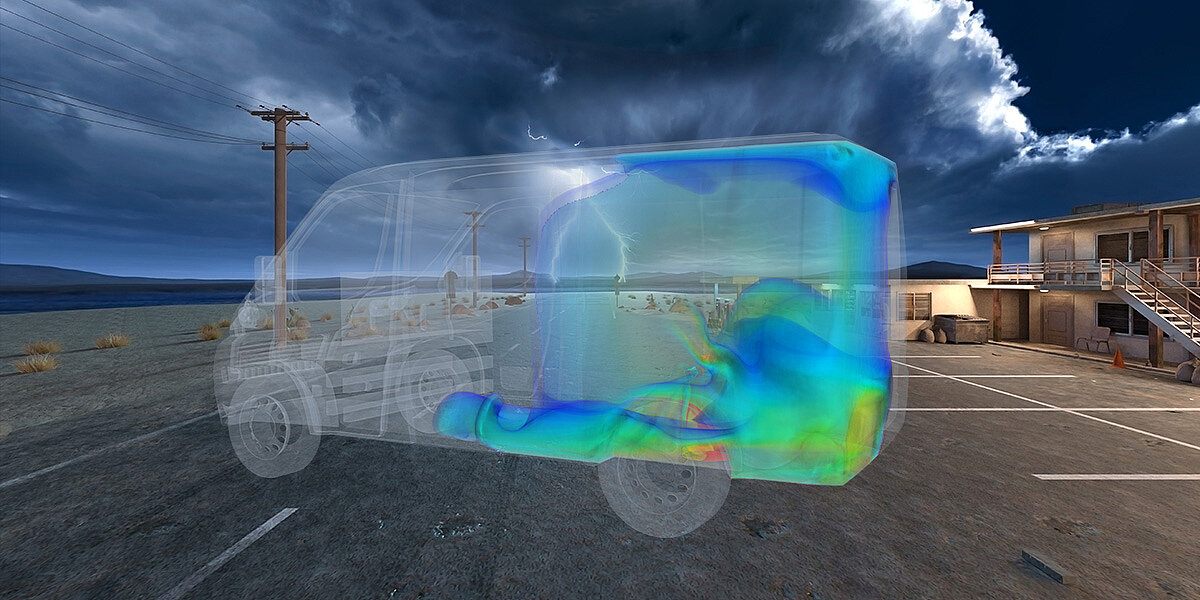Dangerous cargo - transporting gas in a van or motor home


Time and again, accidents occur during the transport of explosive gases where gas leaks have led to an explosion.
However, commercial gas transports are often not the problem at all. Here, there is usually an awareness that a dangerous good is being transported. It is much more critical when there is a small leakage of a gas cylinder in a tradesman's vehicle or a motor home that goes unnoticed. Too often, the driver is not even aware of the risk.
In order to better prevent such accidents in the future, I am working on the development of appropriate standards at EUMOS - the European Safe Logitics Association - an association that works to improve safety throughout the logistics chain.
For this purpose, we carried out various simulations on our own to investigate whether a possibly envisaged forced ventilation of vans and transporters is at all expedient.
But let's take it one step at a time. When is there a danger of explosion in a gas-air mixture?
This is the case at a certain gas concentration, which is defined by the lower and upper explosion limits of the respective gas. If the gas concentration is within this range, there is a danger of explosion.
There are explosive gases that are heavier than air and there are some that are lighter than air.

In our CFD simulations, we considered propane, which is slightly heavier than air. The lower explosion limit here is 4%, the upper explosion limit 10.8%.
In a moving vehicle, such as a van in our example, air exchange is ensured by the vehicle's interior air conditioning or open windows. But what happens if there is a gas leak and the van is stationary?
Depending on the amount of leakage, the formation of an ignitable mixture and the corresponding danger of explosion is only a question of time, which can last from a few minutes to several days.
In the case of high leakages in the range of several litres per second, a leakage can probably already be perceived by the outflow noises. An explosive mixture is also present here after just a few seconds.
However, small leakage currents are particularly critical in stationary vehicles.
In order to approach the topic via a CFD simulation, in the following we will look at a Fiat Ducato (see Figure 1), which even happens to be the same colour as our Malibu motorhome. After all, I want to know what's going on when I'm on the road with my wife.
So what are the possibilities to reduce a possible risk of explosion?
Standards have the peculiarity that they should present complex relationships as simply as possible and suggest effective measures that also work in practice. Unfortunately, this does not always work...! It's easy to end up with the doubters, who add another safety factor to fundamentally very conservative approaches, just to make sure nothing happens.
There is a saying that even the stupidest person can make something even more complicated, but simplification and concentration on the essential influencing factors are rather something for intelligent people and geniuses. Therefore, in the spirit of an implementable, sensible standard, we try to join the more intelligent side.
So if you can't rule out the leakage, what can you do?
You can detect the gas, e.g. via a sensor, and you can dilute it until the concentration is harmless. Oversaturation, i.e. a gas concentration above the upper explosion limit, is ruled out for reasons of common sense; after all, people have to breathe.
Dilution can be achieved by means of a fan that transports the gas-saturated mixture out of the van or transporter and fresh air into the vehicle.
So it needs an inlet and an outlet, otherwise, depending on the direction of the fan, a vacuum would develop or the van would burst at some point. Both, of course, only theoretical 😉.
Various CFD simulations show that the best result is achieved when the gas is blown out in the roof and a hole at the bottom allows fresh air to enter.
So what power does a fan need to be effective and reduce the risk of explosion? For comparison, under my table is a PC with a fan that delivers about 130 m³/h. It's worth a try. It's clear that if the fan's output is too high and it runs for a long time, the battery will run down. This also reduces the risk of explosion due to the lack of an ignition spark, but a vehicle is also there to be driven.
Can a fan with 20 W ensure that a leakage of 1 l/min in a Ducato does not produce an ignitable mixture?
Anticipating the answer: Yes, it can!
With the same leakage, an explosive mixture is formed locally after approx. 300 seconds, while with the fan running the concentration remains far below the lower explosion limit even after 15 hours.
Video 1 shows the formation of the explosive areas between the lower and upper explosion limits without a fan, Figure 2 the concentration in a much finer resolution after 15 h. The maximum concentration is much smaller than the lower explosion limit of 4% or 0.04.

Further findings from our CFD simulations are:
The essential key figures are the volume of the van and the leakage flow.
The type of gas, on the other hand, plays a subordinate role in forced ventilation. Without ventilation, a heavier gas naturally sinks to the bottom, while a lighter gas concentrates at the top. However, if there is a forced air movement, this effect is subordinate

Fixtures such as tables, seats and cupboards in a camper van probably also have a rather subordinate influence, provided the gas cannot collect somewhere. Likewise, the positions of the fan in the roof and the air inlet in the floor of the van are not of such crucial importance.
A solution with a gas sensor that activates a fan when gas is detected and then sends a message that something is wrong would therefore be intelligent.
Technically, this should not be witchcraft and should remain affordable.
The CFD simulations also show here what is otherwise invisible and help to find intelligent solutions.
It will take some time before the standard is ready; after all, the framework conditions and the limits have to be defined. But when the time comes, I will be happy to inform you.
Yours Stefan Merkle

PS: By the way, did you know that regulations have come out for refrigeration machines that the conventional refrigerants are to be replaced by propane here and that propane is an explosive gas? Sure, a van is a van and a refrigeration machine is a refrigeration machine. But whether it can explode can be found out in both cases via CFD simulations. Maybe by someone who knows about it...? I know someone!